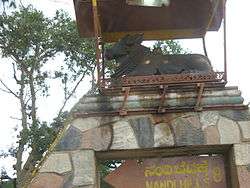Nandi Hills, India
| Nandi Hills, India ನಂದಿ ಬೆಟ್ಟ Nandidurga | |
|---|---|
|
Nandi hills signage | |
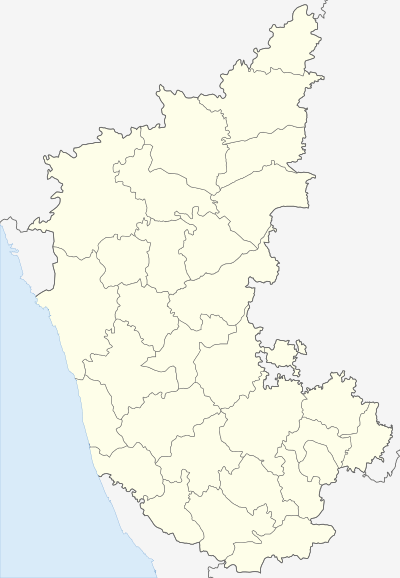 Location in Karnataka, India | |
| Coordinates: 13°23′11″N 77°42′03″E / 13.3862588°N 77.7009344°ECoordinates: 13°23′11″N 77°42′03″E / 13.3862588°N 77.7009344°E | |
| Country |
|
| State | Karnataka |
| District | Chikkaballapur |
| Elevation | 1,478 m (4,849 ft) |
| Languages | |
| • Official | Kannada |
| Time zone | IST (UTC+5:30) |
| Nearest city | Bangalore |
Nandi Hills or Nandi betta (Anglicised forms include Nandidrug and Nandydroog) is an ancient hill fortress in southern India, in the Chikkaballapur district of Karnataka state. It is 10 km from Chickballapur town and approximately 60 km from the city of Bengaluru. The hills are nestled near the town of Nandi. In traditional belief, the hills are the origin of the Arkavathy river.[1]
Etymology and Historical Temple
.jpg)
There are many stories about the origin of the name Nandi Hills. During the Chola period, Nandi Hills was called Ananda Giri meaning The Hill of Happiness.[2] Another story is that Yoga Nandeeshwara performed penance here, and so it was named after him. Nandi is also commonly called Nandidurga (Fort) because of the fort built here by the ruler Tippu Sultan. It is also perhaps called Nandi Hills because the hills resemble a sleeping bull (Nandi).[1]
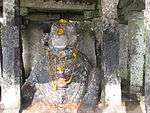
Another theory holds that the hill gets its name from an ancient, 1300-year-old Dravidian-style Nandi temple situated on this hill. An ancient Lord Shiva and Parvati temple also adorns this hill. The Bhoga Nandeeshwara Temple in Nandi village is one of the oldest temples in Karnataka dating back to the ninth century. The temple hewn out of rock consists of two complexes. While the first complex houses three deities, the second complex consists of a huge and majestic kalyani pond. The foundation of the temple was constructed by the Banas of ninth century. The Chola rulers of the 11th century constructed the roof of the temple. The marriage hall was built by the Hoysalas in the thirteenth century and a wall of the second complex was built by the Vijayanagar kings. Beautiful stone carvings are a popular tourist site and are a source of inspiration for students of art and architecture.[3]
Geography
It is 4,851 ft (1,479 m) above sea level. It is located close to the Bangalore International Airport. In addition, the hills are located about 20 km from the National Highway (NH-7) just after Devanahalli Town. Due to its location, Nandi Hills is rapidly developing and numerous commercial and residential ventures are underway in the region.
The Bangalore amateur ham radio operators have a repeater set up on the Nandi Hills, which increases the reach or transmission and reception (Repeater 145.700 (Rx) minus 600 (Tx) with callsign VU2RSB),
History
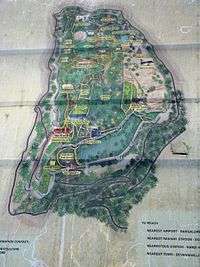
Nandidurga was traditionally held unimpregnable, and its storming by the army of Cornwallis on 19 October 1791 was one of the most notable incidents of the first war against Tipu Sultan of Mysore. A description of the siege is given in Browne's History of Scotland[4] and the records of the 71st Highlanders.[5]
Nundydroog, a celebrated fortress and country of Hindostan, in the province of Mysore. The former is built on the summit of a rock, about 1700 feet high, three-fourths of its circumference being inaccessible. Our forces took it by storm in 1791, after a three weeks' siege. It stands in long. 77° 53' E.,and lat. 13° 22' N.— London Encyclopaedia, 1829[6]
It later became a retreat for British Raj officials during the hot season. Francis Cunningham built the summer residence here for Sir Mark Cubbon.
...this droog, one now used as a hotel, built by General Cubbon, sometime British resident; but the rock has a bad reputation for malaria, and except in the very dry months is shunned by visitors, in spite of its, to the senses, delightful climate— Lt. Gen. E F Burton[7]
The climate at the top of the hill made it particularly of interest to horticulturists. Several species of plant were introduced into an experimental garden. Firminger's manual notes that several species of Anona were grown at this garden and also notes the peculiarity of Hypericum mysorense:[8]
H. mysorense.—An ornamental bush indigenous to the Western Ghauts, but rarely found in gardens. It is domesticated, or wild, in the Fort at Nandidroog, the latter being situated on the top of an isolated hill on the plateau of Mysore at an elevation of 4,850 feet. This is mentioned, as curiously enough, one has to travel more than a hundred miles towards the Western Ghauts, before the plant is met with in the wild state again. Fertile seed has never been secured. The fine yellow flowers are three inches across. Only suitable for the shrubbery in hill gardens.— Burns, 1930[8]
Potato cultivation was introduced for the first time in the neighbourhood of Bangalore by a Colonel Cuppage and continued by the botanist Benjamin Heyne. Heyne brought seeds from St. Helena and these grew well enough that they were supplied in Madras and preferred to those obtained from Bengal.[9] In 1860, tea plants were tried on Nandi Hills by Hugh Cleghorn.[10]
Development

Nandi Hills are currently undergoing development, including a one-crore renovation of the Tipu Fort. The Department of Horticulture is setting up a one-crore food court. A 30-lakh music stage, located on a three-and-a-half acre grove, will be used to conduct cultural programmes.[11][12][13] Furthermore, the Horticulture Department is developing 140 acres (0.57 km2) of land in the Nandi Hills region with the creation of a large-scale exotic botanical garden. A planetarium with an initial one-crore investment is also being constructed.[14] A gondola lift system will connect the peak of the Nandi Hill with the nearby Muddenahalli.[15][16][17][18][19][20] Other projects including Prestige Golfshire and QVC Nandi Hills are coming up near Nandi Hills.[21]
Biodiversity
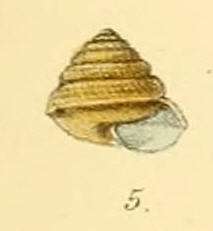
The vegetation of the hills is typical of high hills. Inside the fort at the summit, many of the large trees are planted exotics such as Eucalyptus and the undergrowth consists of Coffea arabica along with some native species. The forest acts as a substrate for cloud condensation and every morning the trees are covered in water. This allows for many moist forest species of plants and animals. The hills are very rich in birdlife making it a very popular location for birdwatchers and bird photographers. The evergreen forest patch on top of the hill being a favoured wintering location for many migrant species of warblers, flycatchers and thrushes. The forest patch is also home for a relict population of the Nilgiri woodpigeon.[22] A breeding pair of shaheen falcon, the resident race of the peregrine falcon is also often seen at the Nandi Hills. The Malabar whistling thrush,[23] Uropeltid snakes and pill millipedes which are otherwise known only from the Western Ghats ranges are also found here. The hill slopes are the home of the yellow-throated bulbul, a species endemic to the hills of peninsular India.[24]
Tourism
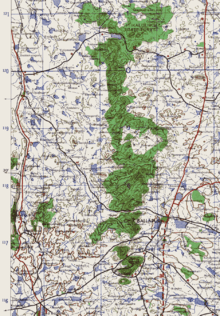
The hills are now a popular tourist spot during summer. The state horticulture department maintains a garden for the tourists. The pressure of tourists on the environment here is great with a considerable problem of litter, noise and physical disturbance.
Tourist Attractions on the Hills
- Tipu's Drop - the famous place from where Tippu Sultan had his condemned prisoners thrown to death.
- Tipu's Summer Palace and Fort - During the Ganga period, the Chikkaballapur chieftains built a fort. Tippu strengthened it further and also built a rest house. This used to be Tippus summer bungalow. It is not open to the general public.
- Horse Way - A stone doorway in the fort on the North-eastern side, is believed to have been the horse way for helping soldiers to climb the wall on horse back.
- Secret Escape Route - A secret passage on the west, is believed to have helped the kings to escape during unforeseen attacks.
- Temples - there are temples dedicated to Sri Bhoga Narasimha, Sri Ugra Narasimha and Sri Yoga Narasimha and you can see beautiful old temples.
- Gavi Veerbhadra Swamy temple: on top of the hill, on the way to the Sultanpet, from Tippus palace, natural formation of huge boulders has been transformed into a magnificent temple.
- Children's Playground - The Horticulture department maintains a lovely garden for children to play games like the slides, merry-go-round, swings etc.
- Nehru Nilaya - where Jawaharlal Nehru used to stay, now a guest house of the horticulture department of India.
- Gandhi House, where the Mahatma himself stayed, is under the management of DPAR (Protocol) Government of Karnataka and is reserved for the stay of important dignitaries.
- The Horticulture Department runs a vegetarian restaurant and the Karnataka Tourism Department runs a vegetarian / non-vegetarian restaurant "MAYURA".
- Rivers - the rivers Pennar, Palar and Arkavati originate from these hills. Most of the sources have dried up. Amruth Sarovar is a beautiful water lake that brims with lucid water all the year round.
- Brahmashram - it is said that Sage Ramakrishna meditated here.
- Paragliding - Nandi Hills is one of the unique place in Karnataka which offers paragliding activity.
- Cycling/biking - Nandi Hills is cyclists paradise, around 400 meters of altitude gain in ~7 km of ride, The bikers/cyclists from Bangalore storm there on weekends and holidays. It's a very good hill training spot for them.
Apart from these, there are other interesting places like Anjaneya temple, Nellikayi Basavanna, Antaragange, Baananthi Bande, etc.
Nearby Tourist Attractions
- Someshwara swami temple (Or Bhoga Nandeeshwara temple) is in the NandiGrama (Nandi village), a couple of km from the base of Nandi Hills.
- Nandi Railway station is about a kilometer from NandiGrama. It is a small, old railway station in the middle of a forest, with big trees.[25]
Skandagiri
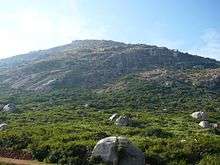
Skandagiri, also known as Kalavara Durga, is a mountain fortress located approximately 62 km from Bangalore city, and 3 km from Chikballapur in the Indian state of Karnataka (13°25′03″N 77°40′58″E / 13.41750°N 77.68278°E). It is off Bellary Road (National Highway 7 Hyderabad-Bangalore Highway), and overlooks Nandi Hills and Muddenahalli. The peak is at an altitude of about 1350 meters. This tourist spot has been closed by the forest department when checked on 21 May 2016, They claimed someone was murdered in the hills and that is the reason its closed for public. [26]
Source of rivers
Nandi Hills is the source of the Penner(ಉತ್ತರ ಪಿನಾಕಿನಿ), Ponnaiyar(ದಕ್ಷಿಣ ಪಿನಾಕಿನಿ), Palar and Arkavathy rivers.
Gallery
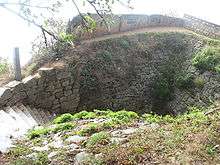 Source of Palar River, Nandi Hills
Source of Palar River, Nandi Hills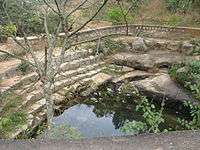 Source of Arkavati River, Nandi Hills
Source of Arkavati River, Nandi Hills Panorama from the base. The main fort hill is to the right.
Panorama from the base. The main fort hill is to the right.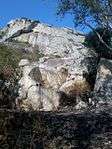 Tipu Drop Cliff - Image shows the depth of Tipu Drop.
Tipu Drop Cliff - Image shows the depth of Tipu Drop. A panoramic view from Nandi Hills.
A panoramic view from Nandi Hills. A view from a cliff at Nandi Hills.
A view from a cliff at Nandi Hills.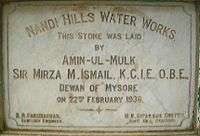 The foundation stone of the waterworks at Nandi Hills.
The foundation stone of the waterworks at Nandi Hills. The foundation stone of the road to Nandi Hills.
The foundation stone of the road to Nandi Hills.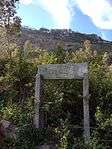 The stairs to climb the hills begin from the village of Sultanpalya
The stairs to climb the hills begin from the village of Sultanpalya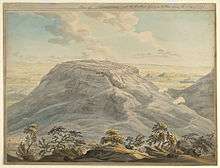 Watercolor view by Colin Mackenzie of the fortress of Nandidurg during the British siege of 1791.
Watercolor view by Colin Mackenzie of the fortress of Nandidurg during the British siege of 1791.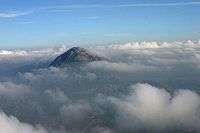 Northern view from Nandi Hills
Northern view from Nandi Hills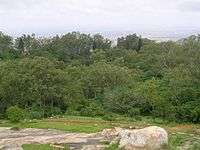 View of the forest patch from above. This is the habitat of the Nilgiri wood pigeon. A peninsular rock agama basks on the rock in the foreground.
View of the forest patch from above. This is the habitat of the Nilgiri wood pigeon. A peninsular rock agama basks on the rock in the foreground.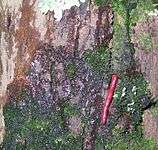 In the early mornings, cloud condensation brings in water, increasing the growth of mosses and lichens. Here a millipede feeds on the detritus on the tree.
In the early mornings, cloud condensation brings in water, increasing the growth of mosses and lichens. Here a millipede feeds on the detritus on the tree.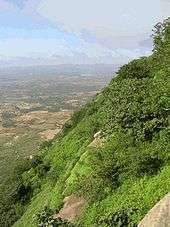 The scrub covered hill slopes, habitat of the yellow-throated bulbul.
The scrub covered hill slopes, habitat of the yellow-throated bulbul.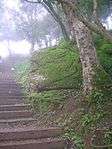 The steps leading from the fort entrance to the summit are surrounded by vegetation that forms ideal habitat for various species of wintering thrushes and warblers.
The steps leading from the fort entrance to the summit are surrounded by vegetation that forms ideal habitat for various species of wintering thrushes and warblers.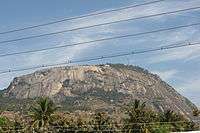 Nandhi hills from a nearest village.
Nandhi hills from a nearest village.- On way to Nandi Hills.
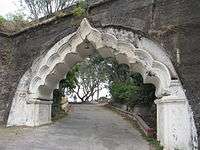 Nandi Hills Fort:Entrance 1
Nandi Hills Fort:Entrance 1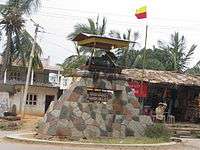 Sign to Nandi Hills: 8 km
Sign to Nandi Hills: 8 km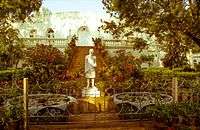 Nehru Nilaya
Nehru Nilaya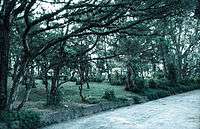 Beautiful view of nandi hill
Beautiful view of nandi hill hills around nandi hill
hills around nandi hill
- View from Nandi Hills
References
- 1 2 Welcome to Nandi Hills
- ↑ "Nandi Hills".
- ↑ From Here & There
- ↑ Browne, James (1909) The history of Scotland. Vol. 8. Francis A. Niccolls. pp. 10-11
- ↑ Hildyard HJT Lt (1876) Historical record of the 71st Regiment Highland Light Infantry. Harrison and sons. scan
- ↑ Anon, 1829 The London Encyclopaedia. Vol. 16 scan
- ↑ Burton, E F (1888) An Indian Olio. Spencer Blackett. London. p. 145 Scan
- 1 2 Burns, W (1930) Firminger's manual of gardening for India. Thacker and Spink. Sixth edition.
- ↑ Royle, John Forbes (1840). Essay on the productive resources of India. London: W.H. Allen.
- ↑ "Tea cultivation in India". The public ledger. 13 November 1860. p. 3 – via British Newspaper Archive.
- ↑ The Hindu : Karnataka News : Food court at Nandi Hills
- ↑ Mangalorean.Com- Serving Mangaloreans Around The World!
- ↑ The Hindu : Karnataka / Bangalore News : Yeddyurappa sets target for ‘2020’
- ↑ Mangalorean.Com- Serving Mangaloreans Around The World!
- ↑ Centre okays GPS for KSRTC buses
- ↑ The Hindu : Karnataka / Bangalore News : And now, here comes horticulture tourism
- ↑ The Hindu : Karnataka News : Facilities at Nandi Hills to be improved
- ↑ The Hindu : Karnataka News : IIT will be established at Muddenahalli, says Moily
- ↑ Silk city to come up near B’lore
- ↑ The Hindu : Karnataka News : International sports village location to be finalised soon
- ↑ http://economictimes.indiatimes.com/News/News-By-Industry/Services/Hotels--Restaurants/Marriott-to-build-luxury-hotel-near-new-Bangalore-airport/articleshow/2946699.cms. Retrieved 9 November 2009. Missing or empty
|title=(help) - ↑ Subramanya, S. (2005). Nesting of Wood-Pigeon Columba elphinstonii in Nandi hills, Karnataka, India. Indian Birds 1(2):36-37
- ↑ Praveen J (2006) Post-monsoon dispersal of Malabar Whistling Thrush Myiophonus horsfieldii (Vigors) to Chamundi Hill and Nandi Hills, Karnataka, Southern India. Zoos' Print Journal 21(9):2411 PDF
- ↑ Subramanya,S; Karthikeyan,S; Prasad,JN (1991) Yellowthroated Bulbul at Nandi Hill. Newsletter for Birdwatchers. 31(3&4):7-8.
- ↑ http://www.theindia.info/blog/paragliding.htm
- ↑ http://www.deccanherald.com/content/521480/trekkers-surprised-ban-skandagiri-hills.html
External links
| Wikimedia Commons has media related to Nandi Hills. |
- State govt's official site
-
 Nandi Hills travel guide from Wikivoyage
Nandi Hills travel guide from Wikivoyage - The birds of Nandi hills
- Paragliding At Nandi Hills
- Nandi Hills
- Paragliding Expirence at Nandi Hills
- Temples in Nandi Hills
